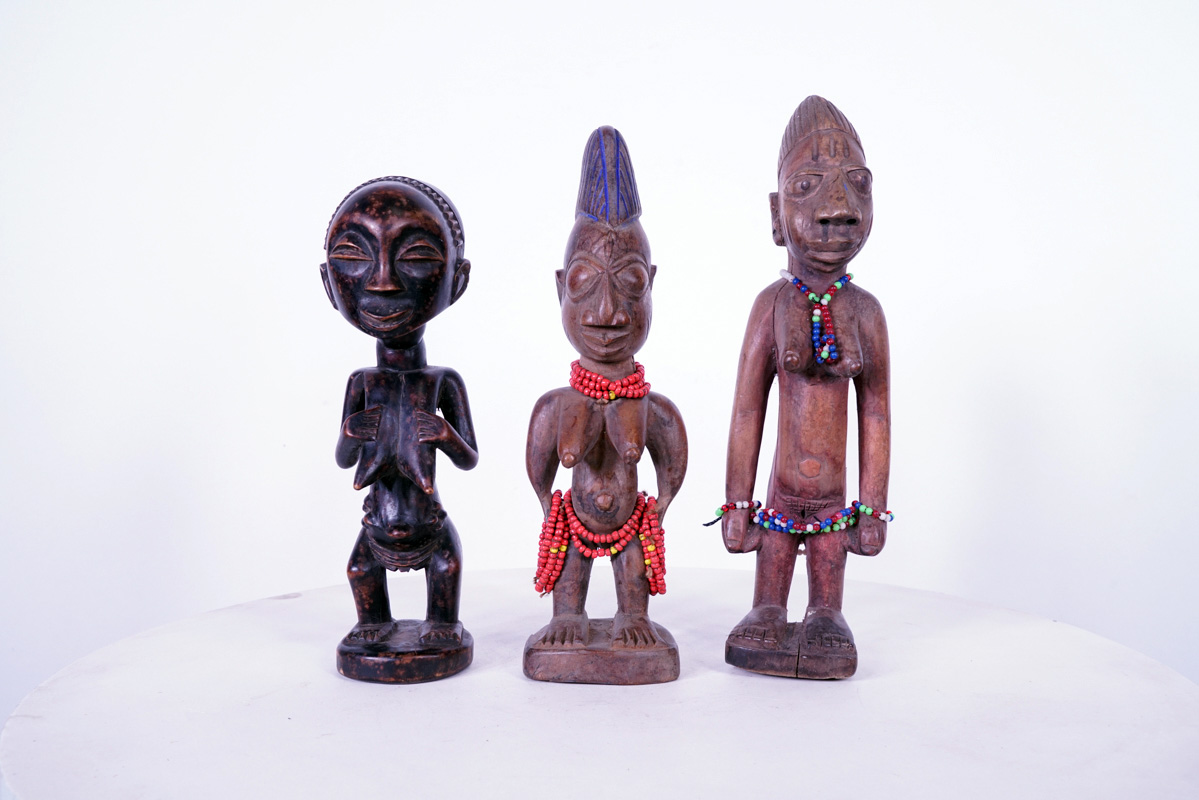These statues were created in the style of the Yoruba people of Nigeria and Luba people of DR Congo. Each statue showcases a standing female figure. Two of the statues are known as Yoruba Ibeji figures and feature colorful beads They measures 10.5 to 12 inches tall and weigh 1 pound each. There is some cracks, scrapes and scuffs throughout – please inspect images.
African Tribal Art Figure Lot 10.5″-12″ – Nigeria & DR Congo
Original price was: $380.00.$95.00Current price is: $95.00.
Sold

| Type of Object | 3 statues |
|---|---|
| Ethnicity | Luba, Yoruba |
| Material | Wood, Pigment, Beads |
| Approximate Age | Unknown |
| Height (Inches) | L: 10.5"; Center: 11.25" ; R:12" |
| Width (Inches) | L: 3.25"; M: 3.25"; R: 3.5" |
| Depth (Inches) | L: 3.5"; M: 3.5: ; R: 4" |
| Weight (Pounds) | 1 lb each |
| Overall Condition | Cracks, scrapes and scuffs – see photos |
Tribe Information
About the Luba People
“The Luba empire was founded in 1585 in the Upemba depression by King Kongolo. His nephew and successor, Kalala Ilunga, rapidly expanded the kingdom to encompass all the territories on the upper left bank of the Lualaba River. At its peak, about one million people, living in several tribes, were paying tribute to the Luba king. At the end of the 19th century, with the advance of the Ovimbudu people from Angola and the raids of the East African Muslim slavers, the empire weakened and, in fact, collapsed when Belgian colonials took control.
With the Assistance of a court of notables, called Bamfumus, the king, known as the Mulopwe, reigned over his subjects through clan kings called Balopwe/ These clan kings could symbolically become the Mulapwe’s son which created client states throughout the empire. A secret society, Bambudye, kept the memory of the Luba empire alive and permeated throughout Luba territory, bonding the diverse populations together. The Luba empire economy was complex – it was based on a tribute system and the redistribution of resources from agriculture, fishing, hunting and mining. The production of salt and iron was under the king’s control.”
Source:
Baquart, Jean-Baptiste. The Tribal Arts of Africa. New York: Thames and Hudson Inc. 1998. Print.
About the Yoruba People
The Yoruba are the largest cultural group on the African continent, with nearly 40 million people. The word ‘Yoruba’ describes both the language and a tribe living across Nigeria and the Popular Republic of Benin, in an area of forest and savannah.
Geography
The Yoruba people’s primary living space is South-West Nigeria with substantial Yoruba communities in Benin, Togo and Sierra Leone but they are not bound by state or country borders. This area is often referred to as “Yorubaland”. Most of the terrain is either forest, woodland savannah, rich farmland or coastal swamps and lagoons.
History
The origin of the Yoruba people in Nigeria is heavily debated. Some believe they came from the east in Mecca, some say from the north in Egypt. Evidence shows that ethnically, Yoruba’s have been in the area known as Yorubaland since the 7th century BC. Scholars believe the area was probably inhabited earlier by peoples of the Nok culture. Yorubaland covers the modern-day countries of Nigeria, Togo and Benin. The term Yoruba to describe ethnicity, did not come about until the 16th century and wasn’t widely used until the 19th century. Before then, the Yoruba people were known by many names depending on who was acknowledging them. For instance, the Europeans referred to them as Akú, whereas in Cuba, they were referred to as O luku mi.
Read more about the Yoruba here.
You must be logged in to post a review.







Reviews
There are no reviews yet.